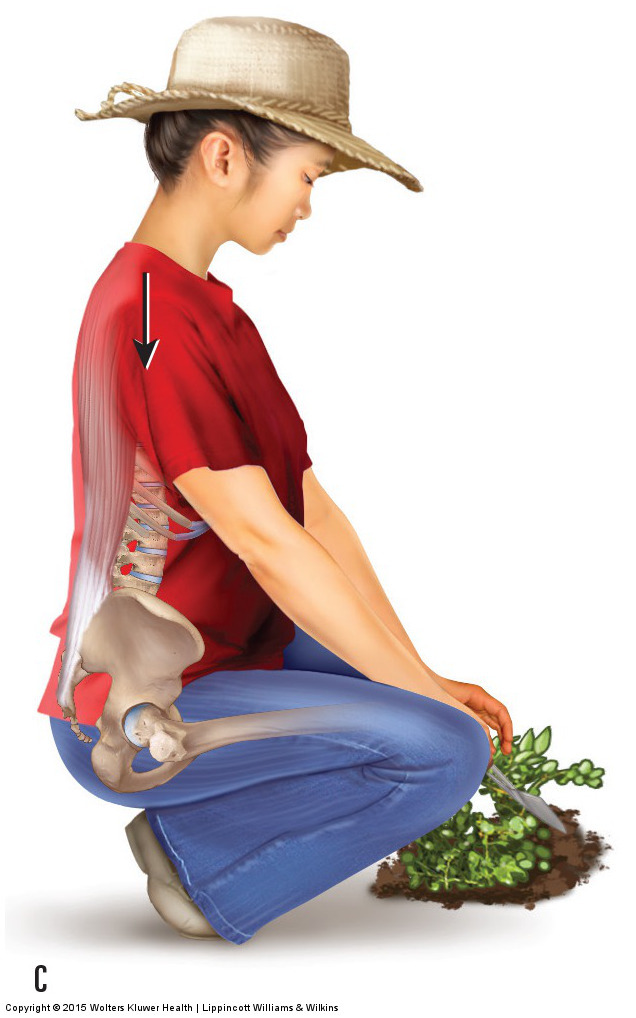Self-care for the client/patient for low back strain and/or sprain:

For a client with a low back strain or sprain, bending the hips, knees, and ankles is a healthy posture when bending or working down in front of the body. Permission: Joseph E. Muscolino. Manual Therapy for the Low Back and Pelvis – A Clinical Orthopedic Approach (2015).
Self-care is an extremely important aspect of the treatment for a low back strain or low back strain strains. First, the client/patient should avoid offending postures and activities such as bending and lifting. Prolonged sitting and standing should also be avoided as much as possible. If swelling is present, ice should be applied until the area is numb (approximately 8-12 minutes depending on how cold the ice pack is). If there is no swelling, then moist heat followed by stretching is extremely important to reduce the muscle spasming. For faster improvement, this should be done at least three times a day. Clients/patients may also choose to take over-the-counter anti-inflammatory medication.
Once the spasming has been reduced, recommend to the client/patient to engage in a core-strengthening program. This is especially important if the client/patient suffered a sprain. This program should include spinal extension exercises and abdominal curl-ups/crunches. Pilates is an excellent way to strengthen the core.
Medical approach to low back strain and/or sprain:
A low back strain and/or sprain usually resolve well with manual therapy, so referral to a physician is rarely needed. When consulted, the medical approach is usually to prescribe rest, over the counter or prescription anti-inflammatory medication (nonsteroidal or steroidal [prednisone] depending upon severity), and use of a brace If pain is present. Pain medication and muscle relaxants may also be prescribed.
Manual therapy case study for low back strain / sprain:
Oz is a 21-year-old university student who is working a summer job at a large retail store. His job requires lifting and stacking boxes all day. He started noticing mild pain and low back tightness approximately one week ago. Three days ago, while bending down to pick up a heavy box, he felt a pop and immediate pain in his right low back. The pain has not improved since then and he is not able to work. On a pain scale of 0-10, his pain is an 8 first thing in the morning, reduces to a 3-4 after a hot shower and moving around, but then increases to a 6-7 by the end of the day.
The therapist performed active and passive straight leg raise (SLR) testing. Oz was positive to active SLR on the right side with pain experienced at approximately L4-5 on the right side when his thigh was flexed approximately 45 degrees; the pain reproduced was characteristic of the pain that he has been experiencing. Passive SLR was performed to 80 degrees and was negative. Manual resistance (MR) to attempted thigh flexion also reproduced his low back pain. All tests for a space-occupying (nerve compression) lesion were negative with no referral into the lower extremities.
Active flexion and left lateral flexion of his trunk (thoracolumbar spine) were decreased in range of motion (ROM) and increased his pain. All other ranges of motion were within normal limits and did not increase his pain level. Palpation revealed mild/moderate inflammation at the L4-5 level on the right side over his paraspinal muscles. His entire right side paraspinal musculature was also very tight with multiple trigger points.
Correlating the verbal history of repeated microtraumas followed by a macrotrauma, with the presence of inflammation, positive active SLR and MR, and negative passive SLR, the therapist assessed OZ with a strain of his right paraspinal musculature. Given the severity of the injury, the therapist recommended treatments every other day for the first week.
Because the injury was still in the acute stage, the therapist avoided any deep work directly to the area of strain (L4-5 level) and instead directed most of the work at the surrounding tight paraspinal musculature. An ice pack was placed on the L4-5 level as soft tissue work was performed with longitudinal (inferior to superior) strokes from L3 upward, beginning with mild pressure and gradually increasing to moderate/deep pressure. This was done for approximately 10-15 minutes. Gentle effleurage was then performed at the region of strain for 5-10 minutes, with both longitudinal and cross fiber strokes, while heat was applied to the rest of the patient’s/client’s low back. Gentle double knee to chest stretching was then performed. This entire protocol was then repeated. This approach was used for the first three treatments.
After the first three treatments, the swelling was gone so the therapist ceased using ice and instead switched to heat, and began to introduce mild to moderate pressure to the region of strained musculature. The therapist followed a protocol of moist heat, soft tissue manipulation, stretching, with gentle joint mobilization at the end. With any time left over, the rest of Oz’s back and his buttocks and thighs were worked.
Oz was given self-care instructions to rest and to ice his right low back as often as possible for the first week. After the first week, his self-care instructions were changed to taking hot showers followed by stretching a minimum of three times per day.
At the end of two weeks, Oz felt approximately 90% better and was able to return to work. Care was continued at twice per week for another week and then decreased to once per week for another two weeks until Oz became pain free. The therapist recommended that Oz begin a regular strengthening and stretching program with emphasis on his core. It was also recommended that Oz return for massage approximately once a month.


